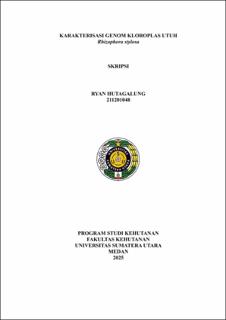| dc.description.abstract | Mangrove forests are crucial ecosystems that are currently under significant pressure from human activities such as land-use changes, pollution, and the exploitation of resources for aquaculture and urban development. One of the affected mangrove species is Rhizophora stylosa, known as a salt-accumulating mangrove with the ability to adapt to extreme environmental conditions. This study aims to characterize the complete chloroplast genome of Rhizophora stylosa using a sequencing-based approach that relies on Next Generation Sequencing (NGS) technology to support conservation and rehabilitation efforts. The sequence data were retrieved from NCBI and analyzed through several steps, including initial quality control, trimming and filtering using Trimmomatic, post-filtering quality control, genome assembly with GetOrganelle, and annotation using GeSeq. The study found that the chloroplast genome of Rhizophora stylosa has a circular structure with a total length of 131,651 bp, comprising the LSC, SSC, and two IR regions. The genome contains 111 essential genes, including photosystem I and II genes (psaA, psbA), ATP synthase, NADH dehydrogenase, as well as various rRNA and tRNA genes. The GC content ranges from 36% to 37%, which is consistent with the characteristics of tropical plant species. The sequence data obtained were of high quality and free from adapter contamination. Information on this chloroplast genome is essential for understanding population structure, genetic diversity, and gene flow among Rhizophora stylosa populations. It is expected that the results of this study can serve as a guideline for selecting appropriate seed sources in conservation and rehabilitation programs to prevent the risk of outbreeding depression and to maintain the local adaptation of the species. | en_US |


